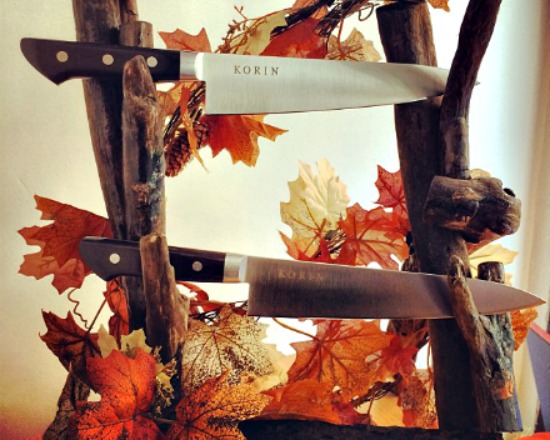Going out for sushi is easy, but making sushi is way more fun. Korin, founded in 1982 by a team of knife experts, is a chef’s knives and tableware shop that makes Japanese cooking accessible for those of us who can’t tell white tuna from fluke. Founder Saori Kawano came to New York in 1978 with one goal: bringing Japanese knives and tableware to Americans. She has since won numerous awards for her business and expertise, including a 2005 James Beard Foundation Angel Award.
Korin sells everything from sushi robots to vaccum-packed bamboo leaves, but they’re best known for their knives. Korin has given us a crash course on traditional Japanese knives, with information on everything from the type of fish they’re intended for to where they originated. Check out the photos in the slideshow above and the corresponding descriptions below. All we need is some raw fish and seaweed, and we’ve got ourselves a dinner in the making!
1. The deba is often used in Japanese fish markets and restaurants that work with whole fish, because it is designed to behead and fillet fish without damaging the fish. Although many use the deba on other meats, it is not intended for chopping large diameter bones nor should it be used by slamming down the knife like a cleaver. For best results, put pressure on the spine of the knife to make clean and precise cuts. Originated in Kansai (Osaka) region of Japan.
2. The fugubiki is a traditional Japanese style fish slicer, similar to the yanagi. Fugu, or blowfish, is traditionally served on a painted plate and cut extremely thin so the design on the plate can be seen through the sliced fish.
3. The takobiki is a variation of the yanagi and is used to slice straight-cut sashimi. It’s thin body makes cutting thin slices of fish easier than the yanagi. The blunt tip and balanced weight works well on difficult ingredients such as octopus, from which it gets its name. Originated in Kanto (Tokyo) region.
4. The usuba (top) is a traditional Japanese knife used to cut or make thin sheets of vegetables. Originated in Kanto (Tokyo) region of Japan. The Kamagata Usuba (bottom) is a traditional Japanese knife used to cut or make thin sheets of vegetables. Unlike the Kanto version of the usuba, the kamagata usuba has a pointed tip, which allows for more delicate work. Originated in Kansai (Osaka) region.
5. The yanagi is used to slice boneless fish fillets into sashimi and toppings for sushi. The graceful, thin blade cuts beautiful slices in one long, drawing stroke. Originated in Kansai (Osaka) region.
Korin will be selling their knives at What’s Cooking on November 13 and donating a Togiharu Hammered Textured Damascus 8.2” Chef’s Knife for our raffle! This knife, with a retail value of $149, is crafted from top grade Japanese-style steel. It is created with a 50/50 double-edged blade and is made under the well-known brand name Togiharu. Don’t miss out on the chance to win this treasure!



